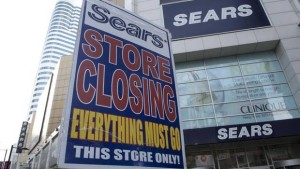As many Canadians have noticed, Sears Canada is free-falling into oblivion. In the last 6 months, Sears Canada has closed many of its prime urban retail locations as they retreat towards the suburbs (where they first started out), layed off many employees, they have had to deal with employees making racist remarks (among many other customer service issues), and they are in the midst of suffering a long and painful decline in revenues.
Once upon a time, Sears was a major player in retail – a one-stop shop where one could purchase almost everything they need at a reasonable price. Now, walking into a Sears is one of the most depressing retail experiences imaginable. In an effort to ‘clean up’ their stores for a more enjoyable experience, they simplified their in-store displays for a less cluttered look. However the reality is that while removing a lot of merchandise from the floor, they forgot to repaint the walls, replace the 1970’s era flooring (and staff) and just generally clean up the place. It was a half-assed attempt at trying to revitalize their image, and that lack of care for the little things does not inspire consumers to shop there. It looks like they know the end is near, and are just waiting to be put out to pasture.
Even though Sears has clearly thrown in the towel and continue to do many things wrong, there is a fatal flaw that precipitated this collapse: their failure to recognize the changing dynamics of their core audience – the middle class.
Middle Child Syndrome
As a middle child myself, I like to think of myself as an expert in all things middle-child-related, and the big thing that people point about middle children is that they yearn to stand out as they are neither the baby of the family, nor are they the prodigal first child. The same can be said of today’s middle-class. In the digital age, consumers are exposed to a multitude of options, and they are becoming more informed about what is potentially available to them. The result is that the middle-class doesn’t want to have a whole array of middle-of-the-road items. The middle class would rather enjoy the cost savings of purchasing the bulk of their items at discount retailers, in order to afford a few luxury, high-end items, with luxury retailers developing new lines of “accessible luxury” to tempt them. Don’t believe me? Walk into any Wal-Mart and count how many people perusing the aisles are carrying around Louis Vuitton bags. The whole idea of the middle-class consumer has become completely muddied as a result, and it is no longer appropriate to simply bucket customers based on their incomes. In the past, Sears thrived on this middle-income demographic, mainly because discount retailers had not yet achieved the prominence that they have today, and the lack of internet provided less opportunity for the middle class to learn about luxury items that appeared unattainable. But today, this is no longer the case.
As the World Turns
A second and perhaps more concerning change to the core audience of Sears which failed to spur this retailer into action, is the altogether hollowing out of the middle-class. This creates a division between the lower end of the spectrum and the higher end of the class spectrum. The ensuing consumer gap leads consumers to perceive that they are either at the bottom end of the two-tiered divide (and thus are making most of their purchases at discount retailers), or they are at the other end of the class spectrum and are spending their cash at higher end retailers, in an effort to keep up with the Joneses. This hollowing out and changing self-perception of the middle class has resulted in a declining potential customer base for Sears, with diminishing opportunities for growth, let alone halting their decline.
Sears has not done itself any favours by the way they have treated customers of late, for by the state of their retail locations. However the issue that precipitated their demise was their inaction in the face of a shrinking customer base that has evolved in terms of how they make their purchases. Sadly, even if Sears made the appropriate personnel and retail design changes, their brand equity has suffered immensely and their core customers have probably already moved on.



 Home
Home